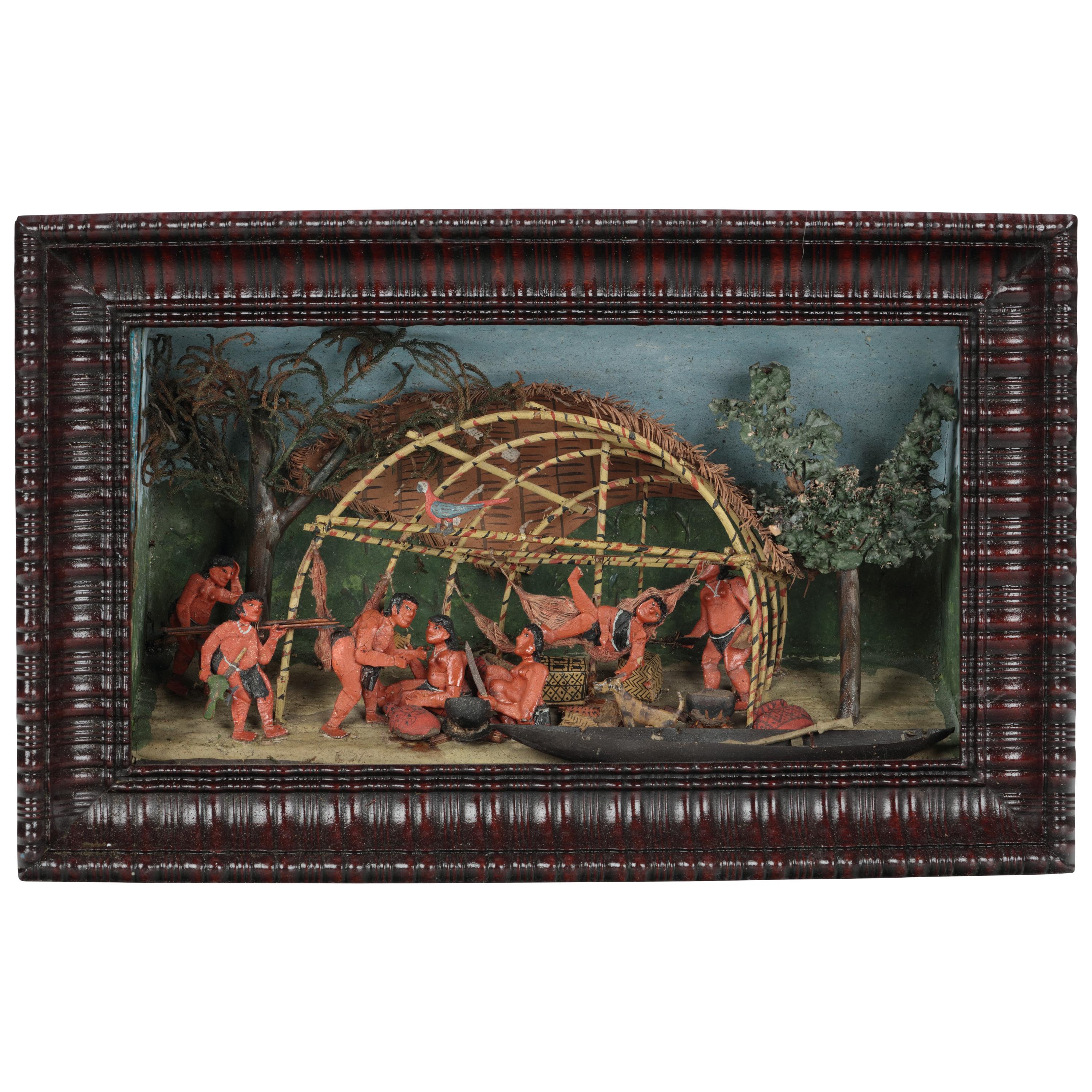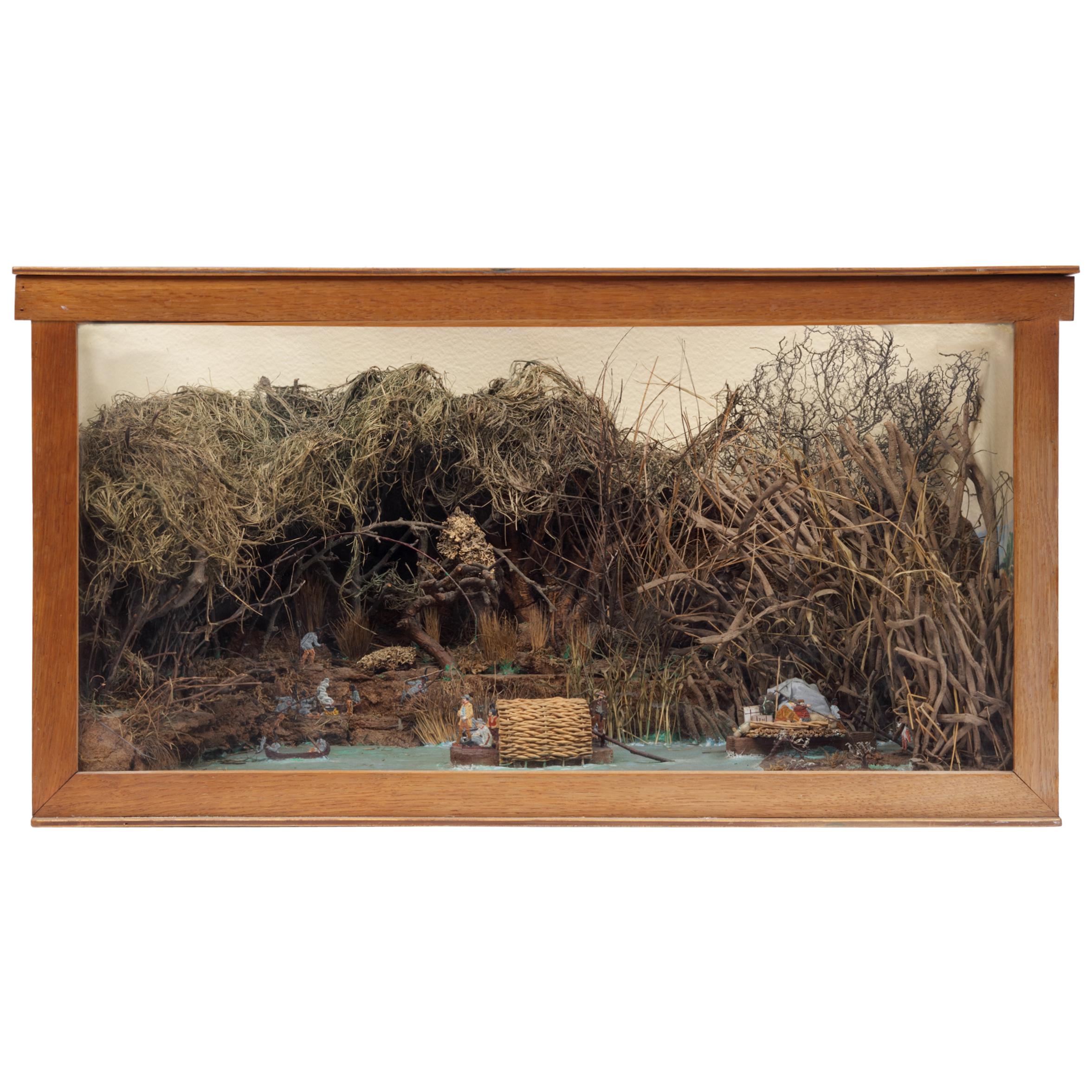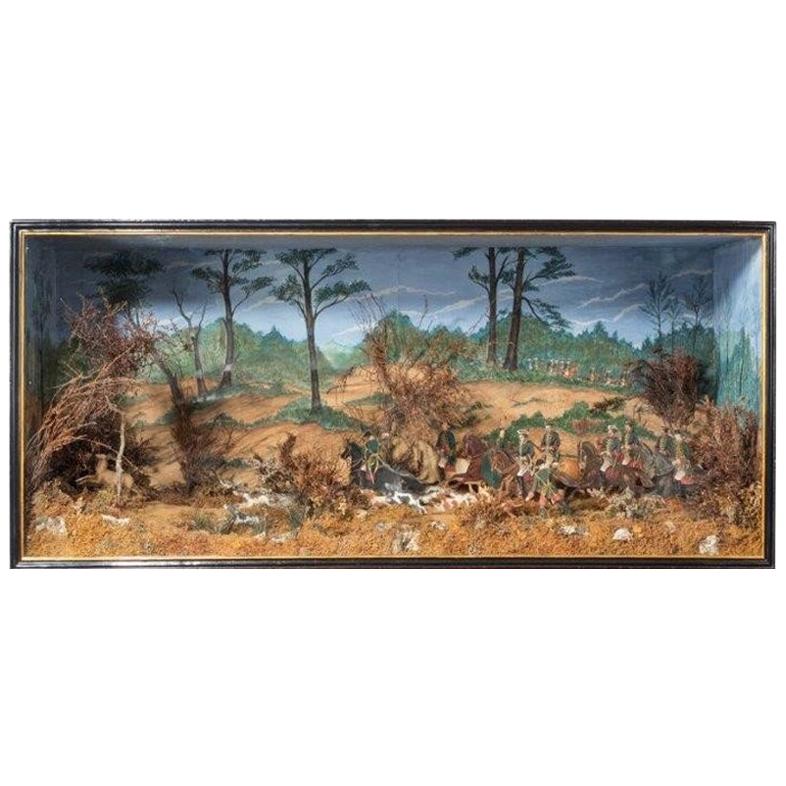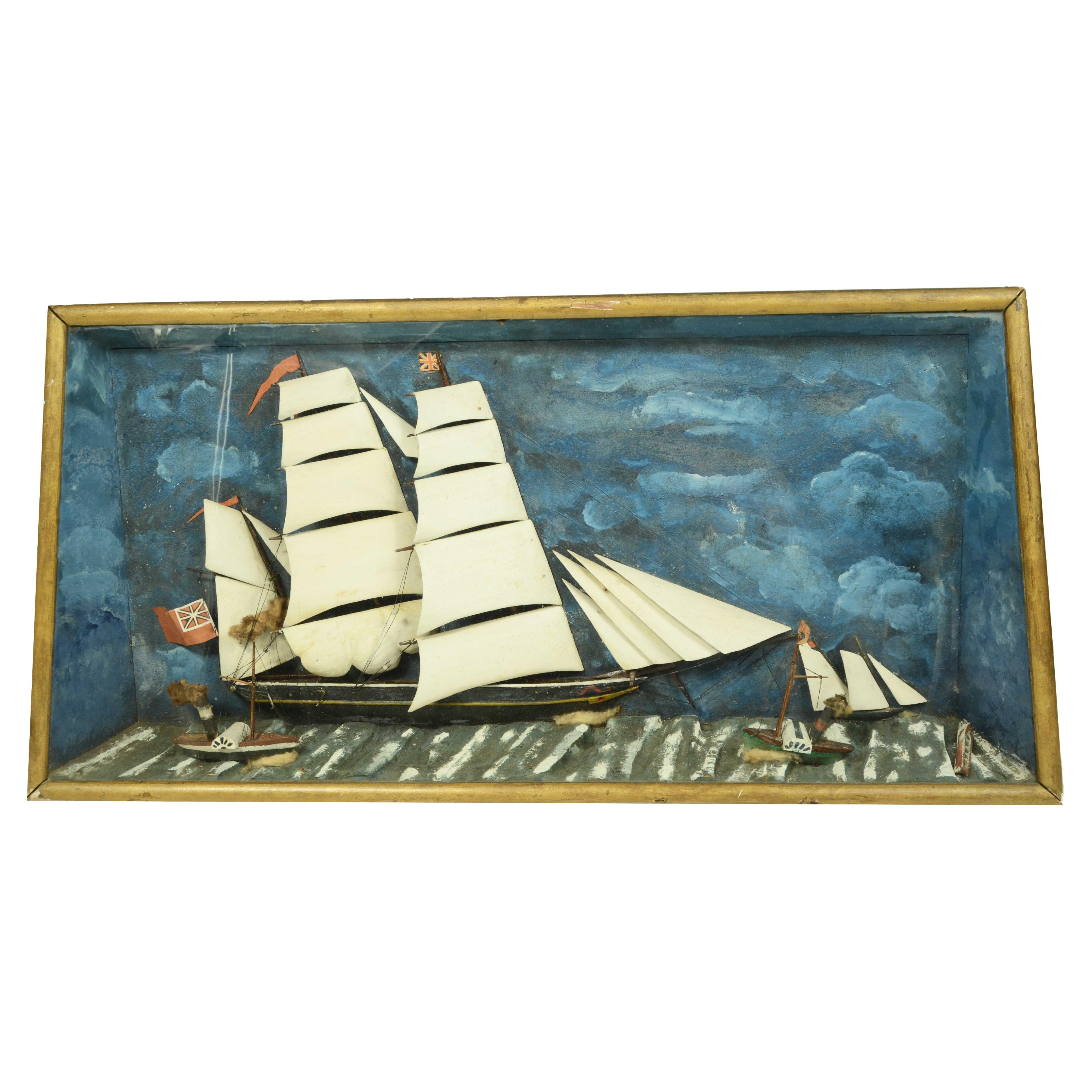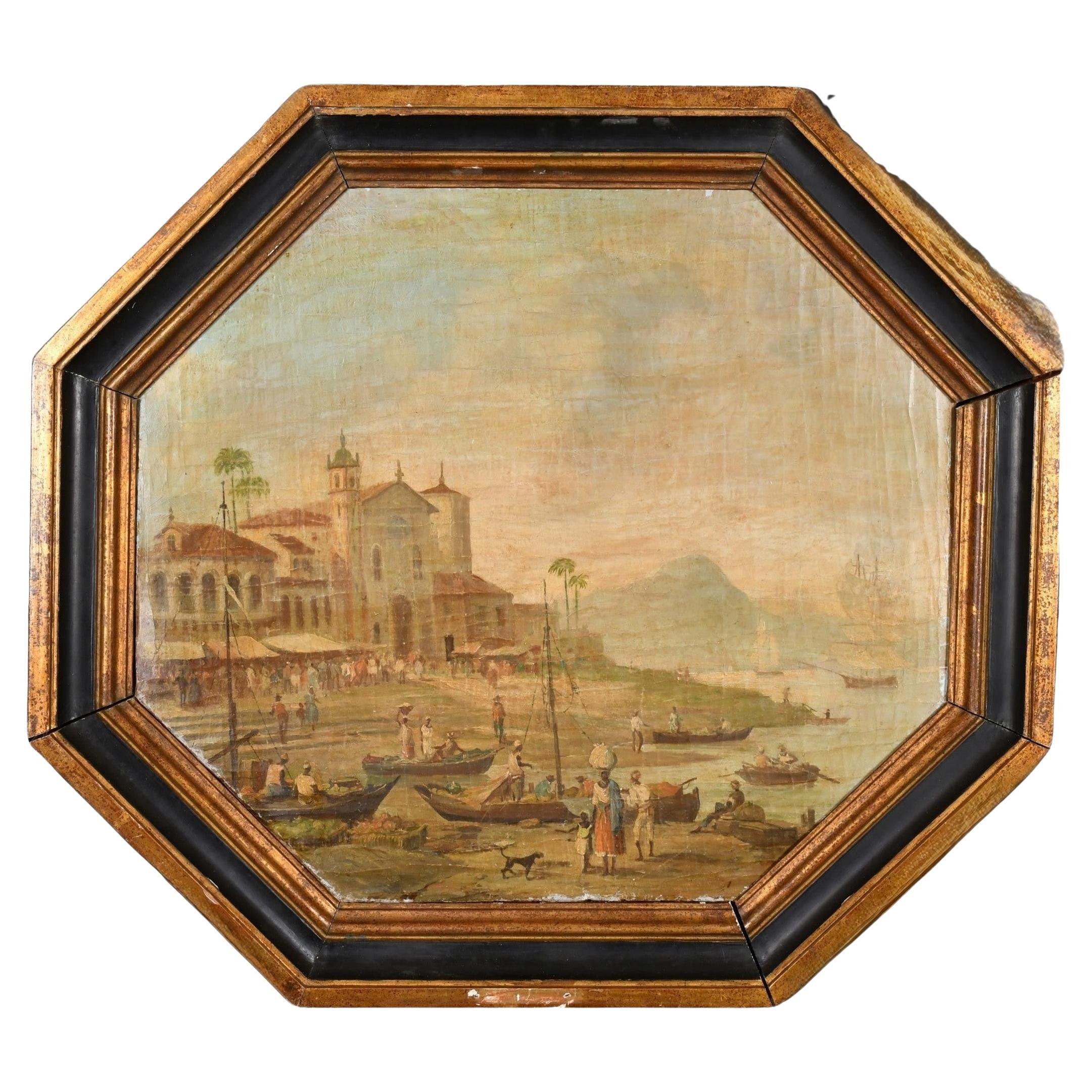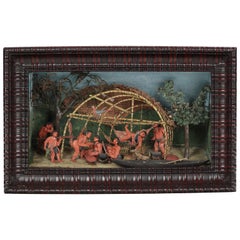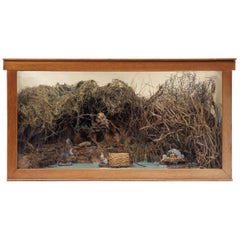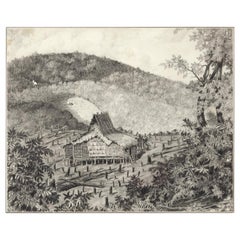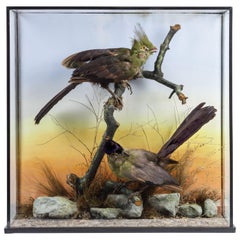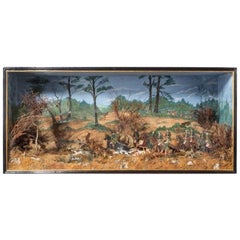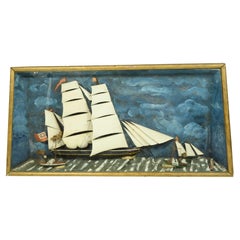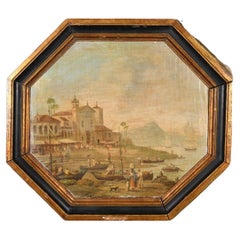Items Similar to Rare Anthropological Diorama of Carib Indigenous by Hendrik Schouten
Want more images or videos?
Request additional images or videos from the seller
1 of 3
Rare Anthropological Diorama of Carib Indigenous by Hendrik Schouten
$53,317.39
£39,691.33
€44,500
CA$73,031.49
A$81,226.96
CHF 42,414.20
MX$988,445.75
NOK 541,694.01
SEK 508,013.42
DKK 338,762.96
Shipping
Retrieving quote...The 1stDibs Promise:
Authenticity Guarantee,
Money-Back Guarantee,
24-Hour Cancellation
About the Item
Hendrik Samuel Schouten (1785-1840)
A unique diorama depicting Carib Indigenous at the river side
Wood, paint on paper, twigs and dried moss
Measures: H. 51 x W. 69.5 x D. 20 cm
Note:
This is the only known diorama by Hendrik Schouten. He became a planter and inherited the Jagtlust plantation from his grandfather Samuel Loske. His older brother Gerrit Schouten (1779-1839) became the well-known artist who made over forty diorama’s, many now in museum collections in the Netherlands and Surinam, and numerous botanical and zoological watercolors of Surinam, most of them now in the Royal Horticultural Society in London. The earliest known diorama by Gerrit Schouten is dated 1810, so one year after this diorama by Hendrik. It is tempting to assume that this first and only diorama by his younger brother was the occasion that started Gerrit to make diorama’s. Gerrit Schouten’s diorama’s of Indigenous camps differ from this one in that Hendrik also used natural materials such as moss and small twigs while Gerrit made everything of papier mâché, Hendrik’s figures are flatter than Gerrit’s.
Gerrit’s diorama’s of Indigenous camps are always viewed from the river towards the camp and his figures are almost always facing the observer while in this diorama most figures, together with the observer, look towards the river. The present diorama is described and illustrated in the exhibition catalogue Gerrit Schouten (1779-1839), botanische tekeningen en diorama’s uit Suriname, Clazien Medendorp 1999, p. 134-135 and was included in the exhibitions in Het Tropenmuseum Amsterdam and Het Surinaams museum Paramaribo in 1999.
- Dimensions:Height: 20.08 in (51 cm)Width: 27.37 in (69.5 cm)Depth: 7.88 in (20 cm)
- Materials and Techniques:
- Period:Early 18th Century
- Date of Manufacture:1809
- Condition:Wear consistent with age and use.
- Seller Location:Amsterdam, NL
- Reference Number:1stDibs: LU5458220857742
About the Seller
5.0
Recognized Seller
These prestigious sellers are industry leaders and represent the highest echelon for item quality and design.
Established in 1985
1stDibs seller since 2020
23 sales on 1stDibs
Typical response time: 2 hours
- ShippingRetrieving quote...Shipping from: Amsterdam, Netherlands
- Return Policy
Authenticity Guarantee
In the unlikely event there’s an issue with an item’s authenticity, contact us within 1 year for a full refund. DetailsMoney-Back Guarantee
If your item is not as described, is damaged in transit, or does not arrive, contact us within 7 days for a full refund. Details24-Hour Cancellation
You have a 24-hour grace period in which to reconsider your purchase, with no questions asked.Vetted Professional Sellers
Our world-class sellers must adhere to strict standards for service and quality, maintaining the integrity of our listings.Price-Match Guarantee
If you find that a seller listed the same item for a lower price elsewhere, we’ll match it.Trusted Global Delivery
Our best-in-class carrier network provides specialized shipping options worldwide, including custom delivery.More From This Seller
View AllAmerican Diorama, Follower Gerrit Schouten, Carib Indigenous Village
Located in Amsterdam, NL
Follower of Gerrit Schouten (second half of the 19th century)
Diorama depicting a Carib Indigenous camp
Carved wood, papier-mâché, paint on paper...
Category
Antique 19th Century Surinamer Native American Objects
Materials
Clay, Twig, Wood, Paper, Feathers
Unique Diorama Depicting a North-American River Scene with Natives and Settlers
Located in Amsterdam, NL
Unique diorama depicting a North American river-scene
United States of America, early 20th century
Measures: H 36 x W 68.5 x D 34 cm
The dioram...
Category
Early 20th Century American Native American Objects
Materials
Other
Collection of Colonial Drawings Depicting Indonesia by J.G. Sinia '1875-1948'
Located in Amsterdam, NL
A Collection of Thirteen Ink and Chalk Drawings by Johan Gerard Sinia (1875-1948)
All framed in gilt-metal or giltwood frames
Sinia started his professional career as an army off...
Category
Early 20th Century Indonesian Dutch Colonial Paintings and Screens
Materials
Other
$29,953 / set
Free Shipping
Victorian Display Box with Taxidermy Turako's, Rowland Ward, Late 19th Century
By Rowland Ward
Located in Amsterdam, NL
A Victorian display case with taxidermy turaco birds, labelled for and by George F. Butt for Rowland Ward
Late 19th-early 20th century
The...
Category
Antique 19th Century English Late Victorian Taxidermy
Materials
Other
Very Large Edwardian Display Cabinet with Sea-Birds, circa 1900
Located in Amsterdam, NL
A very large Edwardian taxidermy case with European sea-birds
Early 20th century
The birds perched on a rocky sea ledge with droppings and plants, naturalistically mounted...
Category
Early 20th Century English Edwardian Taxidermy
Materials
Other
A Chinese 'European subject' reverse glass painting after an English print
Located in Amsterdam, NL
Canton, late 18th century
In original hardwood frame with ruyi-shaped metal mount for suspension.
H. 38.7 x W. 44.3 cm (incl. frame)
H. 31.8 x W. 37.5 cm (image)
Chinese reverse glass paintings for export are known since mid 18th century. By the 1780's the copying of European, mainly English, engravings came into vogue in Chinese paintings on glass...
Category
Antique Late 18th Century Chinese Paintings
Materials
Glass
You May Also Like
Large Handcarved Nautical Diorama from the Romanoff Caviar Co.
Located in Wormelow, Herefordshire
An exceptional early 20th century handcarved nautical diorama framed with glass above an associated 19th century mahogany console table with Carrara marble top.
Ex. property of a Br...
Category
Early 20th Century German Edwardian Models and Miniatures
Materials
Carrara Marble
Rare Continental Three Dimensional Cut Paper Diorama
Located in Lymington, Hampshire
A rare Continental three dimensional cut paper diorama showing a band of green liveried huntsmen chasing a stag in a wooded landscape, in a mahogany show case, circa 1850. On a later...
Category
Antique Mid-19th Century British More Furniture and Collectibles
Materials
Paper
Nautical diorama in wood and glass case of a schooner with English sails unfurled
Located in Milan, IT
Nautical diorama in wooden and glass case with pyramidal shape depicting half hull of a wooden schooner with full sails flying the English flag. 1 sailing ship, two small pyrovelie...
Category
Early 20th Century Nautical Objects
Materials
Wood
Early 19th century Capriccio Brazil School Painting
Located in Seaford, GB
Rare Early 19th century Capriccio view of Rio de Janeiro Painting
Probably painted circa 1810 by one of Jean-Baptiste Debret, Italian Students.
Painted on Sailcloth.
Historical Context of Early 19th Century Portuguese Colonial Brazil
1.1 Transition from Colony to Empire
During the early 19th century, Brazil underwent a seismic shift in its political status. Originally a colony under the Portuguese Empire, the arrival of the Portuguese Royal Court in Rio de Janeiro in 1808 rapidly elevated the city’s cultural and political importance. By 1815, Brazil was declared a kingdom united with Portugal, setting the stage for the emergence of the Empire of Brazil in 1822. This period of transformation—often termed the transitional period from colony to empire—fueled a wave of artistic production in cities like Rio de Janeiro.
1.2 European Artistic Influence in Brazil
With the French Artistic Mission in Rio (initiated in 1816) and the presence of various Portuguese and European artists, Brazilian art of the early 1800s began to reflect diverse influences, from neoclassical painting to the early rumblings of romanticism. Painters such as Jean-Baptiste Debret, and Nicolas-Antoine Taunay, and local luminaries like Manuel de Araújo Porto-Alegre contributed to the fine arts tradition in Brazil. Their works featured scenes of local life, portraits of Brazilian society, and imaginative vistas—sometimes referred to as “capriccios,” in which real elements were combined with artistic liberties to create an idealized panorama.
1.3 Rio de Janeiro as Cultural and Political Hub
Rio de Janeiro, often called the Imperial capital after Brazil’s independence, was home to foundational institutions like the Imperial Academy of Fine Arts (Academia Imperial de Belas Artes). Later evolving into the Escola de Belas Artes (School of Fine Arts in Rio), these academies nurtured the talents of emerging painters, who found patronage under the Royal Court and, subsequently, the Imperial Court. The city’s significance was further enhanced by the construction of significant buildings, the modernization of infrastructure, and the mingling of European courtly customs with the traditions of local inhabitants.
. Description of the Octagonal Oil on Canvas: A Capriccio View of Rio de Janeiro
2.1 Composition and Layout
The most striking characteristic of this 19th-century Brazilian art piece is its octagonal shape, a relatively unusual format that draws the viewer’s gaze toward its centre. The composition showcases Rio de Janeiro’s shoreline in the early 1800s, brimming with merchant ships and smaller boats anchored near the shore. On the sand, there is a bustling crowd of local people—men and women carrying food and goods on their heads, loading and unloading boats, and engaging in everyday commerce. The backdrop of soaring mountains suggests Rio’s iconic topography, embodying the landscape that famously defines the city.
2.2 Architectural and Religious Landmarks
On the left side, one can discern the silhouette of a church believed to be Santa Lucia, a significant religious structure in the heart of early 19th-century Rio. This element provides viewers with a tangible reference point, linking the scene to an actual location. However, because this painting is labelled as a “capriccio,” the artist might have taken creative liberties by rearranging or amplifying certain features of the city. The melding of real and idealized elements is characteristic of these imaginative vistas.
2.3 Evoking Daily Life in Colonial Rio
One of the painting’s greatest appeals lies in its portrayal of daily life during the colonial era. Men and women from various backgrounds populate the scene. Some appear to be carrying goods on their heads, a common practice in Brazil that has persisted through different centuries. Others appear to be haggling or trading near small vessels, revealing the commercial pulse of an active port city. This focus on local people, combined with the grandeur of merchant ships, captures the tension and synergy between the every day and the extraordinary—a hallmark of Brazilian colonial painting that balances the grand narratives of empire with the rhythms of ordinary life.
2.4 An Amalgamation of Neoclassical and Romantic Influences
Although academic art in early 19th century Brazil was highly influenced by neoclassicism, the onset of romanticism can be spotted in the emotional portrayal of the sky, the lively palette, and the dramatic emphasis on nature’s beauty (the mountains, in particular). This duality reflects the fine arts tradition in Brazil during the transitional phase when artists were embracing multiple styles. As part of the School of Rio or the Rio de Janeiro school, painters often integrated academic techniques learned from European masters with emerging local subjects and influences.
3. Institutions and Artistic Movements
3.1 Imperial Academy of Fine Arts
Originally known as the Royal School of Sciences, Arts, and Crafts, the Imperial Academy of Fine Arts in Rio de Janeiro was instrumental in shaping 19th-century Brazilian art. Influential artists and teachers from Portugal, France, and other European nations congregated at the Academy, imparting their expertise to native students. As the monarchy consolidated power, the Academy enjoyed royal patronage, leading to the creation of Imperial Academy-style works that combined European academic rigour with Brazilian-themed subject matter.
3.2 Impact of the French Artistic Mission
The French Artistic Mission, which arrived in 1816, played a pivotal role in introducing advanced European artistic techniques, thereby elevating the overall quality of painting in Brazil. Artists like Jean-Baptiste Debret not only documented Brazilian society but also spearheaded the development of a local visual identity that aligned with both academicism and the national context of a blossoming empire. Debret, alongside others such as Nicolas-Antoine Taunay, mentored Brazilian artists, sowing the seeds of what would become the Brazilian academic art movement.
3.3 Religious, Historical, and Landscape Paintings
In addition to everyday scenes and historical compositions, religious iconography remained crucial throughout Portuguese colonial and imperial Brazil. Churches were omnipresent in cityscapes like Rio de Janeiro. Many colonial-era Brazilian portraits...
Category
Antique Early 19th Century Brazilian Spanish Colonial Paintings
Materials
Canvas
$2,959 Sale Price
20% Off
Orientalist Engraving after Horace Vernet, Empire Period
By Carle Vernet (Antoine Charles Horace Vernet)
Located in North Hollywood, CA
Orientalist engraving after Horace Vernet, wood frame, Empire period
Orientalist engraving depicting Rebecca at the Fountain giving a drink to...
Category
Early 20th Century French Moorish Decorative Art
Materials
Paper
Pair of Antique Museum Dioramas, Circa 1940
Located in Faversham, GB
A rare and rather wonderful pair of antique dioramas, originally used as museum teaching aids to educate about the cultures of the world and their trad...
Category
20th Century British Mid-Century Modern Figurative Sculptures
Materials
Plastic, Acrylic, Pine
$432 Sale Price / set
20% Off
More Ways To Browse
Indigenous Furniture
Botanical Model
Antique Twig Furniture
Antique Wood Appliques
Antique Diorama
Antique Anthropology
Miniature Diorama
Carved Diorama
Antique Paper Mache Molds
Museum Diorama
Carved Wood Diorama
H Schouten
Gerrit Schouten
Salesman Sample
Salesman Samples
French Cannon
Model Ship In Glass Case
Salesman Samples Furniture
